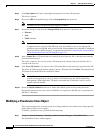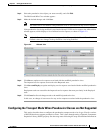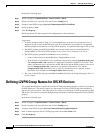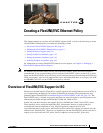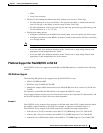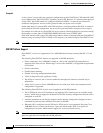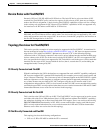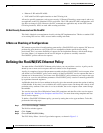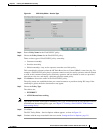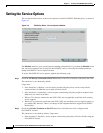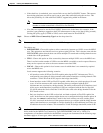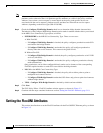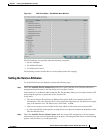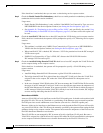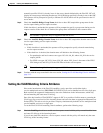
3-6
Cisco IP Solution Center L2VPN and Carrier Ethernet User Guide, 6.0
OL-21636-01
Chapter 3 Creating a FlexUNI/EVC Ethernet Policy
Defining the FlexUNI/EVC Ethernet Policy
• Ethernet U-PE and/or PE-AGGs.
• N-PE with FlexUNI-capable interface on the CE-facing side.
All service-specific parameters, such as port-security, L2 Protocol Tunneling, storm control, and so on,
are applicable to the UNI (Standard UNI) in such links. The U-PE and/or PE-AGG configurations will
also have no change in CLIs. However, the EVC commands are applicable only on the N-PE (on the
CE-facing interface). NPCs are used while creating such links.
CE Not Directly Connected and No FlexUNI
This link is identical to an attachment circuit in existing ISC implementations. This has a standard UNI
as in existing ISC services. NPCs are used while creating such links.
A Note on Checking of Configurations
ISC attempts to provision all configurations generated by a FlexUNI/EVC service request. ISC does not
perform any prior checks to verify if the CLIs are compatible with the specific devices being
provisioned. This is to ensure flexibility of support for device/platform features, which could change
over time. Hence, it is important for the service designer or operator to carefully create the
FlexUNI/EVC policies and service requests.
Defining the FlexUNI/EVC Ethernet Policy
You must define a FlexUNI/EVC Ethernet policy before you can provision a service. A policy can be
shared by one or more service requests that have similar service requirements.
A policy is a template of most of the parameters needed to define a FlexUNI/EVC service request. After
you define it, a FlexUNI/EVC policy can be used by all the FlexUNI/EVC service requests that share a
common set of characteristics. You create a new FlexUNI/EVC policy whenever you create a new type
of service or a service with different parameters. FlexUNI/EVC policy creation is normally performed
by experienced network engineers.
An Editable check box in for an attribute in the policy gives the network operator the option of making
a field editable. If the value is set to editable, the service request creator can change the value(s) of the
particular policy attribute. If the value is not set to editable, the service request creator cannot change
the attribute.
You can also associate Cisco IP Solution Center (ISC) templates and data files with a service request.
See
Appendix B, “Working with Templates and Data Files,” for more about using templates and data
files in service requests.
To define a FlexUNI/EVC Ethernet policy, you start by setting the service type attributes. To do this,
perform the following steps.
Step 1 Choose Service Design > Policies.
The Policies window appears.
Step 2 Click Create.
Step 3 Choose FlexUNI (EVC) Policy.
The EVC Policy Editor - Service Type window appears, as shown in Figure 3-1.



